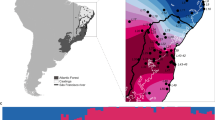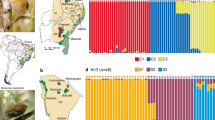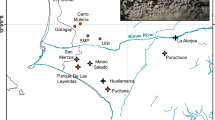Abstract
The Canadian lynx, distributed all across the northern part of North America, is well known for its regular population cycles—cycles that have different underlying structures in different parts of Canada1. Using both nuclear and mitochondrial DNA markers, we report here a close resemblance between the earlier observed spatial ecological structuring of the Canadian lynx1 and its spatial genetic structuring. Specifically, we demonstrate that the Rocky Mountains represent a barrier to gene flow in western Canada, and, somewhat surprisingly, we detect the presence of a geographically invisible barrier south of Hudson Bay (coinciding with the separation between the ecological Continental and Atlantic regions1). No evidence for isolation in different glacial refugia within North America was found. We suggest that ecological factors underlying the spatial dynamic structuring also strongly influence the genetic structuring of the Canadian lynx.
This is a preview of subscription content, access via your institution
Access options
Subscribe to this journal
Receive 51 print issues and online access
$199.00 per year
only $3.90 per issue
Buy this article
- Purchase on Springer Link
- Instant access to full article PDF
Prices may be subject to local taxes which are calculated during checkout



Similar content being viewed by others
References
Stenseth, N. C. et al. Common dynamic structure of Canada lynx populations within three climatic regions. Science 285, 1071–1073 (1999)
Krebs, C. J. et al. Impact of food and predation on the snowshoe hare cycle. Science 269, 1112–1115 (1995)
Stenseth, N. C., Falck, W., Bjornstad, O. N. & Krebs, C. J. Population regulation in snowshoe hare and Canadian lynx: Asymmetric food web configurations between hare and lynx. Proc. Natl Acad. Sci. USA 94, 5147–5152 (1997)
Elton, C. S. & Nicholson, M. The ten-year cycle in numbers of the lynx in Canada. J. Anim. Ecol. 11, 215–244 (1942)
Stenseth, N. C. et al. From patterns to processes: Phase and density dependencies in the Canadian lynx cycle. Proc. Natl Acad. Sci. USA 95, 15430–15435 (1998)
Mowat, G., Poole, K. G. & O'Donoghue, M. in Ecology and Conservation of Lynx in the United States (eds Ruggiero, L. F. et al.) 265–306 (University Press of Colorado, Denver, 2000)
Krebs, C. J., Boutin, S. & Boonstra, R. Ecosystem Dynamics of the Boreal Forest: The Kluane Project (Oxford Univ. Press, New York, 2001)
Ranta, E., Kaitala, V. & Lindström, J. Dynamics of Canadian lynx populations in space and time. Ecography 20, 454–460 (1997)
Schwartz, M. K. et al. DNA reveals high dispersal synchronizing the population dynamics of Canada lynx. Nature 415, 520–522 (2002)
Burton, C., Krebs, C. J. & Taylor, E. B. Population genetic structure of the cyclic snowshoe hare (Lepus americanus) in southwestern Yukon, Canada. Mol. Ecol. 11, 1689–1701 (2002)
Dawson, A. G. Ice Age Earth: Late Quaternary Geology and Climate (Routledge, London, 1992)
Hewitt, G. M. Some genetic consequences of ice ages, and their role in divergence and speciation. Biol. J. Linn. Soc. 58, 247–276 (1996)
Fedorov, V. B. & Stenseth, N. C. Multiple glacial refugia in the North American Arctic: Inference from phylogeography of the collared lemming (Dicrostonyx groenlandicus). Proc. R. Soc. Lond. B 269, 2071–2077 (2002)
Kurtén, B. & Anderson, E. Pleistocene Mammals of North America (Columbia Univ. Press, New York, 1980)
Templeton, A. R., Routman, E. & Phillips, C. A. Separating population structure from population history: A cladistic analysis of the geographical distribution of mitochondrial DNA haplotypes in the tiger salamander, Ambystoma tigrinum. Genetics 140, 767–782 (1995)
Avise, J. C. Phylogeography: The History and Formation of Species (Harvard Univ. Press, Cambridge, Massachusetts, 2000)
Templeton, A. R., Crandall, K. A. & Sing, C. F. A cladistic analysis of phenotypic associations with haplotypes inferred from restriction endonuclease mapping and DNA sequence data. III. Cladogram estimation. Genetics 132, 619–633 (1992)
Doebeli, M. & Dieckmann, U. Speciation along environmental gradients. Nature 421, 259–264 (2003)
Greenwood, P. J. Mating systems, philopatry and dispersal in birds and mammals. Anim. Behav. 28, 1140–1162 (1980)
Mowat, G. & Slough, B. G. Some observations on the natural history and behavior of the Canada lynx, Lynx canadensis. Can. Field-Nat. 112, 32–36 (1998)
Slough, B. G. & Mowat, G. Lynx population dynamics in an untrapped refugium. J. Wildl. Mgmt 60, 946–961 (1996)
Poole, K. G. Dispersal patterns of lynx in the Northwest Territories. J. Wildl. Mgmt 61, 497–505 (1997)
Menotti-Raymond, M. et al. A genetic linkage map of microsatellites in the domestic cat (Felis catus). Genomics 57, 9–23 (1999)
Raymond, M. & Rousset, F. GENEPOP (v 1.2): Population genetics software for exact tests and ecumenicism. J. Hered. 86, 248–249 (1995)
Janczewski, D. N., Modi, W. S., Stephens, J. C. & O'Brien, S. J. Molecular evolution of mitochondrial 12S RNA and cytochrome b sequences in the pantherine lineage of Felidae. Mol. Biol. Evol. 12, 690–707 (1995)
Schneider, S., Roessli, D. & Excoffier, L. Arlequin Ver. 2,000: A Software For Population Genetic Data Analysis (Genetics and Biometry Laboratory, Univ. Geneva, Switzerland, 2000)
Rogers, A. R. Genetic evidence for a Pleistocene population explosion. Evolution 49, 608–615 (1995)
Clement, M., Posada, D. & Crandall, K. A. TCS: A computer program to estimate gene genealogies. Mol. Ecol. 9, 1657–1660 (2000)
Templeton, A. R. & Sing, C. F. A cladistic analysis of phenotypic associations with haplotypes inferred from restriction endonuclease mapping. IV. Nested analyses with cladogram uncertainty and recombination. Genetics 134, 659–669 (1993)
Posada, D., Crandall, K. A. & Templeton, A. R. GeoDis: A program for the cladistic nested analysis of the geographical distribution of genetic haplotypes. Mol. Ecol. 9, 487–488 (2000)
Acknowledgements
We are grateful to the wildlife managers and trappers that participated in the sampling, especially D. F. McAlpine, R. Lafond, C. Heydon, B. Verbiwski, A. Arsenault, R. Mulders, P. W. Cotter, M. Badry, C. Apps and T. Shury. We also thank Ø. Flagstad and D. Ehrich for discussions. This work was supported by the University of Oslo and the Norwegian Research Council.
Author information
Authors and Affiliations
Corresponding author
Ethics declarations
Competing interests
The authors declare that they have no competing financial interests.
Supplementary information
Rights and permissions
About this article
Cite this article
Rueness, E., Stenseth, N., O'Donoghue, M. et al. Ecological and genetic spatial structuring in the Canadian lynx. Nature 425, 69–72 (2003). https://doi.org/10.1038/nature01942
Received:
Accepted:
Issue Date:
DOI: https://doi.org/10.1038/nature01942
This article is cited by
-
Insights into subspecies classification and conservation priorities of Central Asian lynx populations revealed by morphometric and genetic analyses
Scientific Reports (2024)
-
Phylogenetic analyses of Eurasian lynx (Lynx lynx Linnaeus, 1758) including new mitochondrial DNA sequences from Iran
Scientific Reports (2022)
-
Microsatellite DNA analysis reveals lower than expected genetic diversity in the threatened leopard cat (Prionailurus bengalensis) in South Korea
Genes & Genomics (2018)
-
Integrating airborne lidar and satellite imagery to model habitat connectivity dynamics for spatial conservation prioritization
Landscape Ecology (2018)
-
Population genetic structure of gray wolves (Canis lupus) in a marine archipelago suggests island-mainland differentiation consistent with dietary niche
BMC Ecology (2014)
Comments
By submitting a comment you agree to abide by our Terms and Community Guidelines. If you find something abusive or that does not comply with our terms or guidelines please flag it as inappropriate.



